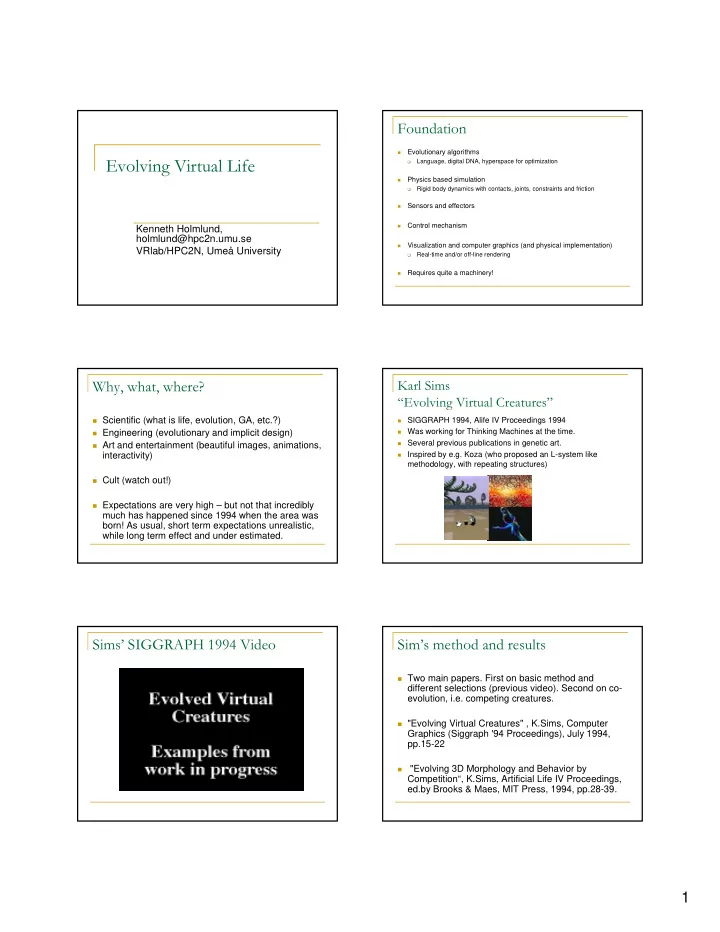

Foundation Evolutionary algorithms � Evolving Virtual Life Language, digital DNA, hyperspace for optimization � Physics based simulation � Rigid body dynamics with contacts, joints, constraints and friction � Sensors and effectors � Control mechanism Kenneth Holmlund, � holmlund@hpc2n.umu.se Visualization and computer graphics (and physical implementation) � VRlab/HPC2N, Umeå University Real-time and/or off-line rendering � Requires quite a machinery! � Why, what, where? Karl Sims “Evolving Virtual Creatures” � Scientific (what is life, evolution, GA, etc.?) � SIGGRAPH 1994, Alife IV Proceedings 1994 � Was working for Thinking Machines at the time. � Engineering (evolutionary and implicit design) � Several previous publications in genetic art. � Art and entertainment (beautiful images, animations, interactivity) � Inspired by e.g. Koza (who proposed an L-system like methodology, with repeating structures) � Cult (watch out!) � Expectations are very high – but not that incredibly much has happened since 1994 when the area was born! As usual, short term expectations unrealistic, while long term effect and under estimated. Sims’ SIGGRAPH 1994 Video Sim’s method and results � Two main papers. First on basic method and different selections (previous video). Second on co- evolution, i.e. competing creatures. � "Evolving Virtual Creatures" , K.Sims, Computer Graphics (Siggraph '94 Proceedings), July 1994, pp.15-22 "Evolving 3D Morphology and Behavior by � Competition“, K.Sims, Artificial Life IV Proceedings, ed.by Brooks & Maes, MIT Press, 1994, pp.28-39. 1
System representation Directed graph for representation � Starting at root node � Nodes Genotype Phenotype � Information (directed graph) (hierarchy of 3d parts) � Dimensions � Joint-type � Joint-limits � Recursive-limit � Neurons � Connections � Child Node � Position � Orientation � Scale � Reflection Control Combining morphology and control Brain is also a directed graph of neurons that can Applied as forces and torques do sum, product, divide, sum-threshold, greater than, sogn-of, abs, max, min, cos, sin, oscillate, etc for input/output processing Joint angle Contacts (self/environment) Photo sensors Combining morphology and control Physical simulation � Rigid-body simulation � Nested graph � Collision detection (bounding box hierarchies) � Blocks of neural circuitry are replicated with � Collision response (projection at high v + penalty at low v) � Contacts each instanced part (otherwise phase space � Friction and viscosity wille be too big and unconstrained) � Forces � Torques � Mass and inertia � Featherstone’s algorithm � Creatures exploit all bugs! This includes violated conservation of energy and momentum, as well as numerical errors! (self slapping, rotating paddle, falling over on box, etc.) 2
Selection – genetic pressure Evolving the system � Start configuration � Behaviour � Minimalistic, random � Swimming � Pre-evolved creatures (also based on completely � ”Walking” different fitness functions) � Jumping � User designed creatures � Follow � Compute survival ratio � Fitness function computed at each step. � Compute fitness value and select the fittest � Interactive selection based on e.g. aesthetics � Reproduce � Evolve and recompute fitness value etc. Evolving the graph (”DNA”) Mating graphs � Directed graph mutation � Internal node parameters � Add random node � Connection parameters altered randomly (small) � Add/remove connections randomly A node of a parent connected Crossover point for copying From parents to child. to a node of the other parent. � Remove unconnected elements � Mutation frequency for each parameter type � Scale mutation frequency with inverse graph Method choosen randomly for each child. 40% asexual size (otherwise evolution easily becomes 30% crossover spurious) 30% grafting Running the simulation Results � Homogeneity � Connection Machine CM-5 with 32 � Swimmers processors – 3 Hours � Paddlers � Population of 300 � Tail-waggers � Survival ratio 1/5 � Walkers � 100 Generations � Lizard-like � 1-5 time steps per frame of 1/30 s � Pushers/Pullers � Hoppers � Followers � Steering Fins � Paddlers 3
Co-evolution Co-evolution � Second paper (Alife IV) � Two creatures compete about possesion about a block Co-evolution Co-evolution Co-evolution Follow up by Tom Ray � Zoology professor � Lots’a spare time in the jungle… � Developed Tierra (http://www.his.atr.jp/~ray/tierra/) � Did Alife 1990-2001 (digital evolution) � Virtual Aesthetic Creatures project � Variations in selection pressure (aesthetic, emotional, empathetic. Love, …etc) � Prettier rendering and commercial movie � Based on Mathengine 1.x physics toolkit (co-developed by Claude Lacoursiere that works with us). � See http://www.his.atr.jp/~ray/ � Software: VirtualLife (still works, but needs Mathengine license file. Ask me if you need help fixing it..). 4
Ray’s Creatures Conclusions How far can we take this? � Not entirely understood � Robotics researchers have created simulations that are based on real self-repeating and varying � building blocks, such that the final result actually can be manufactured. Very interesting, but not really conclusive. Marriages between computing science, physics and biology are fruitful! � It seems that not many are able to integrate evolutionary algorithms, robust physics based � simulation and computer graphics – and at the same time also ask the relevant scientific questions. For some recent research in the area see the work of e.g. Chris Adami: � http://www.krl.caltech.edu/~adami/ and Richard Lenski: http://www.msu.edu/user/lenski/ They have published lots of ground breaking results, but as far as I know nothing where they also do physics simulation. Also see this book: Evolutionary Robotics - The Biology, Intelligence, and Technology of Self- � Organizing Machines Stefano Nolfi and Dario Floreano http://mitpress.mit.edu/catalog/item/default.asp?ttype=2&tid=3684 � Some recent examples following up Sims’ work: http://163.152.22.77/shim/research.htm Tim Taylor and Colm Massey at Mathengine also did some follow up on Sims’ work: � http://homepages.inf.ed.ac.uk/timt/demos/mathengine/index.html 5
Recommend
More recommend